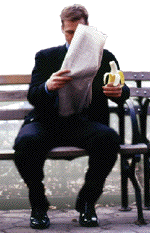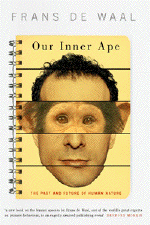La présence éventuelle d'une publicité ci-dessus est insérée par le routeur du mailing-liste indépendamment de mes choix en compensation de la gratuité de son service Dr O Walusinski baillement.com baillement.info yawning.info 

mercredi 1er février 2006 la lettre d'information du site baillement.com N°46 Si vous ne voyez pas les images, cliquez ici pour lire cette lettre dans votre navigateur. If you cannot see pictures below, to view the email in your web browser cliquez ici baillement.com est libre d'accès, base documentaire pour comprendre, chercher, travailler
-
SUNCT Syndrome - Two Cases in Argentina
- Raimondi E, Gardella L
- Headache
- 1998; 38; 5; 369-371

- Lithium-triggered chronic cluster headache
- Brainin M, Elsenstädter A
- Headache
- 1985;25:394-395
- Short-lasting unilateral neuralgiform headache with conjunctival injection and tearing syndrome treated with microvascular decompression of the trigeminal nerve: case report
- Lagares A, Pedro A. Gomez, et al
- Neurosurgery
- 2005; 56; 2; 413
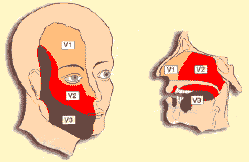
- Headphone neuralgia
- Skelton S
- NEJM
- 1996; 333; 26; 1786-1787
- Glossopharyngeal neuralgia and MS
- Minagar A
- Neurology
- 2000, 54, 1368-70
- Primary yawning headache
- Jacome D
- Cephalalgia
- 2001; 21; 6; 697-69
- Compulsive yawning as migraine premonitory symptom.
- Jacome D
- Cephalalgia
- 2001; 21; 5; 623-625
- Extracephalic yawning pain
- Jacome D
- Cephalalgia
- 2004; 24; 5; 411-413
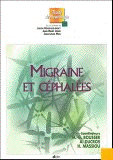
-
Short lasting unilateral nevralgiform headache with conjunctival injection and tearing - or SUNCT syndrome
- The trigeminal autonomic cephalgias (TACs) are a group of primary headache disorders characterised by unilateral trigeminal distribution pain that occurs in association with ipsilateral cranial autonomic features. This group of headache disorders includes cluster headache, paroxysmal hemicrania and short-lasting unilateral neuralgiform headache attacks with conjunctival injection and tearing (SUNCT syndrome). Despite their similarities, these disorders differ in their clinical manifestations and response to therapy, thus underpinning the importance of recognising them.
- SUNCT is a headache syndrome characterized by short-lasting (usually 15-120 sec), unilateral head pain paroxysms localized in the peri-ocular area, accompanied by conjunctival injection, lacrimation, nasal stuffiness, rhinorrhea, and subclinical forehead sweating, all on the symptomatic side. Attacks are especially triggered by touching the supraciliary and upper palpebral areas, and by mastication, laughter, yawning, and lateral head movements.
- The attack frequency varies from less than one attack daily to more than 60 attacks per hour. The attacks are predominantly diurnal, although frequent nocturnal attacks can occur in some patients. The mean age at onset is 50 years. Most patients are thought to have no refractory periods. Episodic and chronic forms of SUNCT exist.
- Concerning the pathophysiology of SUNCT, hypothalamic involvement ipsilaterally to the pain has been suggested based on the clinical features and one functional imaging case report.
- Lamotrigine (125 to 200 mg daily), obtains a complete remission in 20% of the patients and a substantial reduction of attack frequency in about 80%. Surgery of the trigeminal root and microvascular decompression surgeries fail usally to give any benefit (see exception).
- Céphalées trigémino-autonomiques avec injection conjonctivale et larmoiement
- ou SUNCT Syndrome
- Les névralgies faciales regroupent des syndromes d'hyperalgie caractérisés par des zones douloureuses de la face reproduisant la distribution anatomique des branches du trijumeau. Pour certaines s'y associent des symptômes neurovégétatifs. Malgré leur parenté de localisation, il est possible de distinguer différents tableaux en fonction du déroulement de la crise, de l'évolution dans le temps des épisodes algiques, de leurs sensiblités différentes aux traitements.
- Le SUNCT syndrome est caractérisé par des décharges paroxystiques brèves (15 à 120 s) unilatérales, localisées à l'aire périorbitale, avec injection conjonctivale larmoiement, congestion nasale obstructive homolatérale et rhinorrhée, une perspiration sudorale de la joue. Les attaques sont déclenchées par le frottement cutanée de la région du sourcil, de la paupière supérieure, par la mastication, les bâillements, les inclinaisons de la tête.
- Ces paroxysmes peuvent se reproduire de façon très variable, de une fois par jour à une soixantaine à l'heure. Ils surviennent essentiellement le jour, rarement la nuit. Le début de ce trouble apparait le plus souvent au cours de la sixième décade de vie. Habituellement, aucune période réfractaire n'existe.
- D'un point de vue physiopathologique, l'hypothalamus ipsilatéral parait impliqué d'après la clinique et un travail d'imagerie fonctionnelle.
- La lamotrigine (125 à 200 mg par jour) domme une rémission complète chez 20% des malades, et réduit la fréquence et la sévérité des crises chez 80%. Le plus souvent la chirurgie de décompression vasculaire du V est inefficace. (Voir une exception)
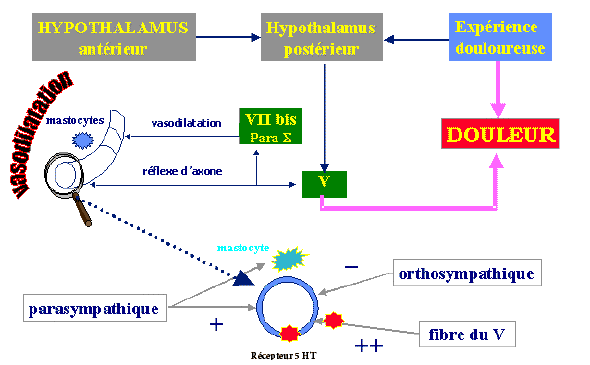
- Sjaastad O, Kruszewski P. Trigeminal neuralgia and "SUNCT" syndrome: similarities and differences in the clinical pictures. An overview." Funct Neurol 1992;7(2): 103-107.
- Pareja JA, Sjaastad O. SUNCT syndrome. A clinical review. Headache 1997;37(4): 195-202.
- Sjaastad O, Pareja JA, Zukerman E, Jansen J, Kruszewski P. Trigeminal neuralgia. Clinical manifestations of first division involvement.Headache. 1997;37(6):346-357.
- Pareja JA, Caminero AB et al. SUNCT Syndrome: diagnosis and treatment. CNS Drugs 2002;16(6): 373-383.
- Matharu MS, Cohen AS et al. Short-lasting unilateral neuralgiform headache with conjunctival injection and tearing syndrome: a review. Curr Pain Headache Rep 2003;7(4): 308-318.
- Pareja JA, Cuadrado ML. SUNCT syndrome: an update. Expert Opin Pharmacother 2005;6(4): 591-599.
- SUNCT syndrome : pdf file of all articles on PUBMED
- E-medicine Chronic Paroxysmal Hemicrania
- Pour tout savoir consulter "la bible" : Migraines et céphalées de MG. Bousser, A. Ducros et H Massiou, Douin éditeur, Paris 2005.
-
Essai sur le tic en général - et en particuliers sur
- le tic douloureux de la pommette
- Guillaume-Antoine Soulagne
- de Villeneuve les Béziers
-
Diagnostic du tic douloureux de la pommette 23 janvier 1804 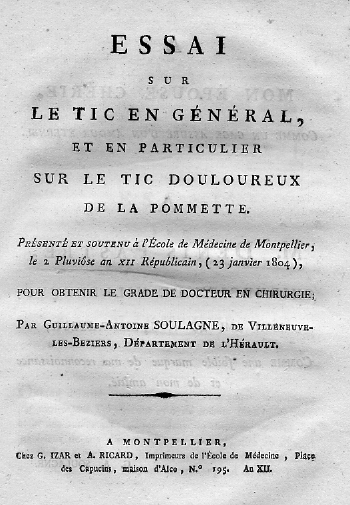
- Quelquefois nul prodrome n'annonce l'accès; d'autrefois il est précédé par des sensations sourdes d'un genre particulier dans le lieu affecté, qui s'animent ensuite insensiblement; des vibrations douloureuses, qu'on peut comparer à des traits électriques, se font ensuite sentir dans cette partie, d'où elles s'irradient en divers sens, et simulent l'impression que ferait un instrument tranchant qui parcouroit la même route.
- Pendant la durée de l'attaque, les sourcils sont froncés, les paupières fortement rapprochées, la commissure des lèvres d'un côté retirée vers l'oreille, comme dans le ris sardonique, la mâchoire inférieure immobile; il y a quelques fois chaleur et rougeur vive à la pommette; la respiration est lente et comme suspendue; souvent le malade s'interdit le moindre cri, le plus léger mouvement dans l'appréhension d'augmenter ou de prolonger ses souffrances: il est, pour ainsi dire, dans un état extatique.
- Cette scène de convulsions et de douleurs se renouvelle par saccades à des intervalles plus ou moins rapprochés; les douleurs sont souvent atroces et déchirantes [...] Lorsque le tic s'est fixé sur l'oeil, un état convulsif s'en empare; il devient douloureux, rouge larmoyant....
-
Behavioural responses following - tooth injury in rats
- Chudler EH, Byers MR
- Arch Oral Biol
- 2005; 50; 3; 333-340
-
The increased number of yawns after tooth injuries in rats - Early changes in spontaneous behaviour (exploration, grooming, freezing, rearing, jaw motion, yawning) and body weight were measured at two and three days after pulp exposure injury and implantation of Fluorogold (FG) into molar teeth of rats.
- Rats with FG and injuries to three teeth gained weight less rapidly, explored less frequently and froze more often than sham-operated rats. Yawning was not observed in any rats prior to surgery and it was seen more frequently in tooth-injured rats than in sham-operated rats.
- These results suggest that careful observation of spontaneous behaviour after tooth injuries can be used to assess dental pain in rats and may provide behavioural markers to correlate with anatomical changes after injury. The dental nerve cell bodies that had accumulated transported FG were medium to large, and they only co-localized calcitonin gene-related peptide (CGRP) in a subset of the medium neurons. Chromatolytic or moribund FG-labelled neurons were also found.
- "A unique observation was the increased number of yawns seen after tooth injuries. Although the significance of yawning following tooth injuries is unclear, it may be related to stress. Yawning can be elicited in horses by abdominal stress and in rats by foot shock stress.
- Yawning is also a symptom of some migraine headaches in humans. It is unlikely that the yawns after tooth injuries were caused by damage to the jaw or temporomandibular joint or to stress of the novel testing environment because sham-operated rats did not yawn. Moreover, because rats do not yawn following infraorbital nerve injury, it is likely that yawning is made in direct response to sensory information from the tooth.
- The use of a rat strain that displays a high frequency of yawning may help resolve this question because such animals might display a higher number of yawns following tooth injuries and reduce the variability of this behavioural marker."
- Augmentation du nombre des bâillements après extractions dentaires chez le rat
- Ce travail analyse le comportement de rats ayant subi une extraction dentaire, afin de pouvoir décrire un modèle animal de la douleur dentaire et du stress secondaire à une extraction.
- Alors que les rats, avant les soins dentaires, ne présentaient que d'exceptionnels bâillements, après extraction, des bâillements répétés sont apparus être le signe le plus constant révélant la douleur et le stress. Comme le suggère l'article ci-dessous, chez le cheval également, douleurs et stress engendrent des bâillements répétés. On peut peut-être comparé ce comportement avec les bâillements répétés accompagnant la migraine humaine.
-
Naloxone-induced abdominal - distress in the horse
- Kamerling SG, Hamra JG, Bagwell CA
- Equine Vet J.
- 1990; 22; 4; 241-243
- Department of Veterinary Physiology, Pharmacology and Toxicology,
- School of Veterinary Medicine, Baton Rouge
- Louisiana
- The effect of naloxone administration on the secretion of corticotropin-releasing hormone, arginine vasopressin, and adrenocorticotropin in unperturbed horses.
- Alexander SL, Irvine CH.
- Endocrinoogy
- 1995; 136; 11;:5; 139-147
- The apomorphine test in heroin addicts
- Casas M , Guardia J, Prat G, Trujols J
- Addiction
- 1995; 90; 831-835
- Acute abstinence syndrome following abrupt cessation of long-term use of tramadol : a case study
- Freye E, Levy J
- European J of Pain
- 2000; 4; 307-311
- Opiate influences on drug-induced yawning in the rat
- Berendsen HG, Gower AJ
- Behav Neural Biol
- 1981; 33; 1; 123-128
- Inhibitory effect of morphine on yawning induced by cholinoceptor and dopamine D2 receptor activation in rats
- Zarrindast, MR, Jamshidzadeh A
- Br J Pharmacol
- 1992; 105; 3; 675-678
-
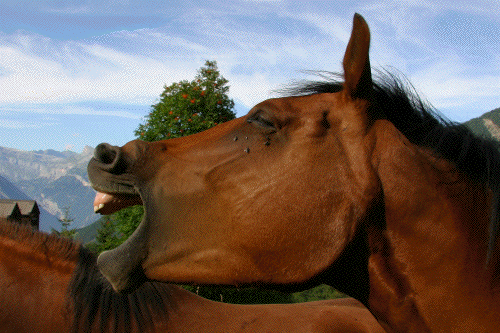
- Endogenous opioid peptides have been implicated in the regulation of pain perception, behavior, gastrointestinal activity and other physiological responses. However, the functional role of these peptides in the horse has yet to be elucidated. The opioid antagonist, naloxone, is often administered to infer endogenous opioid effects.
- In the present study, naloxone (0.75 mg/kg bodyweight) was administered to eight Thoroughbred racehorses and a number of behavioural and autonomic responses were measured. Naloxone produced rapid onset diarrhoea, restlessness, abdominal checking, tachycardia, tachypnoea, paradoxical yawning and diaphoresis.
- These responses described an acute abdominal distress syndrome similar to spasmodic colic. Results from this study suggest that, in the horse, endogenous opioids:
- 1) influence behaviour
- 2) modify intestinal activity and sensation
- 3) if perturbed, may be
involved in pathophysiology of colic.
Les peptides opioïdes endogènes sont impliqués dans la régulation de la perception douloureuse, certains comportements, la motricité gastrointestinale et d'autres processus physiologiques. Jusqu'à présent, peu de recherches les ont étudiés chez le cheval. La naloxone, antagoniste opioïde, est souvent utilisée comme modificateur d'effet. Dans cette étude, la naloxone a été administrée à des chevaux. Le comportement et différents paramètres témoins de l'activité autonomique ont été colligés. Rapidement après l'injection, sont apparus de la diarrhée, une agitation, une tachycardie, une tachypnée, des bâillements paradoxaux, une transpiration profuse.
-
Neuroendocrine correlates - of sleep wakefulness
- Cardinali DP.
- Pandi-Perumal SR.
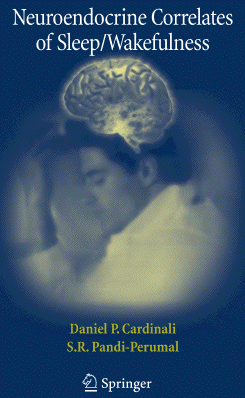
-
As the title suggests, and unlike other existing books on sleep medicine, Neuroendocrine correlates of sleep wakefulness will be devoted primarily to endocrine regulation of the behavioral state control. - It will address a wide spectrum of sleep./wakefulness phenomena (both animals and humans), including pathogenesis, diagnosis, and management. From molecular biology to applied clinical therapy, sleep research has been transformed in the last few years from a research backwater to an important interdisciplinary field. Anyone who regularly reads the literature on sleep, biological rhythms, or neuroendocrinology is aware that one of the subspecialties within sleep medicine, the neuroendocrine correlates of sleep/wakefulness, has in particular experienced a growth rate that is even faster than that of the field as a whole. To a significant extent this has been attributed to the introduction of new research technologies.
- The widespread adoption of a range of new methods in sleep research has opened a window of opportunities to explore at the cellular and molecular level, which previously had been tightly closed. Therefore, this volume promises to provide an exceptional single source of detailed information related to this topic. It will thereofre be of interest to advanced graduate students and specialists in the field of sleep medicine, neuroendocrinology, psychiatry, psychobiology and neurobiology. The editors have selectively identified a number of key articles having a citation frequency, which is considerably above the norm or which otherwise have contributed importantly to defining the neuroendocrine perspective.
- This new volume on Neuroendocrine Correlates of Sleep/Wakefulness is an up-to-date resource of research summaries and reviews written by major contributors to the fields of sleep, biological rhythms and neuroendocrinology. Its coverage is broad and its basic and clinical science reviews are detailed. In this volume, an international team of experts discuss their latest ideas, concepts, methods, and interpretations with supporting examples.
-
Comme son titre le suggère, Neuroendocrine correlates of sleep wakefulness est un livre consacré préférentiellement à une mise au point des connaissances sur les régulations hormonales des mécanismes de l'éveil et du sommeil. - Il couvre un large spectre de travaux, tant chez l'animal que chez l'homme, de l'échelle moléculaire et cellulaire jusqu'aux comportements. Il témoigne de la vitalité de la recherche dans un domaine largement interdisciplinaire tel les rythmes biologiques, l'éveil et le sommeil normaux et pathologiques. Ecrit par une équipe d'experts internationnaux, leaders dans leur domaine, ce livre est une mise au point novatrice et pertinente.
- A noter le chapitre consacré au syndrome de Smith Magenis, rédigé par Dr H. De Leersnyder, pédiatre à Paris, qui a réussi à trouver un traitement pharmacologique de cette maladie génétique (ce qui est exceptionnel).
- Pingfu Feng, de l'université de Cleveland, a rédigé le chapitre d'introduction "The developmental regulation of wake/sleep system" où l'on retrouve de nombreuses données sur l'ontogenèse du sommeil, du sommeil paradoxal en particulier, telles que développées dans Fetal yawning assessed by 3D and 4D sonography.
-
Archaic behavior and - the communicative act
- The meaning of stretching, yawning, rocking and other fetal behavior in therapy
- Joost Meerloo
- Psychiatric Quaerterly
- 1955; 29; 60-73
- Télécharger l'article intégral en PDF
-
Yawning - Psychologically we know that yawning has to do with reminiscences of sleep; but, beyond that, it may indicate also hunger and boredom and even pleasurable leisure. It is a very contagious movement. One person is easily induced by another's yawning to yawn himself. Sometimes compulsive yawning is indulged in with pleasure-orgastic pleasure. Some people yawn when they glide in their rapidly speeding cars, behind the wheel, through the landscape. The word "yawning" is direct onomatopoeia; this makes us aware that it is part of a deeply-founded body function. Yawning pleasure is seen in the infant, not only when he is sleepy but also when he is satisfied.
- Yawning represents yearning for something archaic; it is a remnant of a fetal response. The reflex may last for many seconds, with deep inspiration and expiration. It may be nearly unexpressed behind the hand before the mouth.
- Clinically, the writer found yawning in one patient to be an initial sign preceding an epileptic fit. In the analysis it was associated with a yearning for the breast, or for something even more deeply nirvanic, and was then followed by a furious epileptic attack because of the denial.
- How deeply yawning and yearning are related came to the fore in a manic-depressive patient who went through twilight states in which he experienced complete union with the prenatal mother. Consciously, this was a frightening experience for him. However, it always announced itself by periods of compulsive yawning, making it possible for him to go home and surrender more freely to his reminiscences. In such a twilight state, the patient had all kinds of telepathic experiences, described in a former publication (Meerloo, 1949).
- Yawning plays a greater role in the therapeutic situation than is often realized. The therapist also yawns. One cannot always interpret this as a form of negative transference, because the increased communication in the therapeutic situation may easily lead to a common archaic fantasy.
-

- rue Antoine Dubois
- Paris 5°
- Projet de Jean Baptiste Carpeaux (1827-1875)
- auteur de la statue
- exécutée par Ernest Hiolle (1834-1886)
- sculpteur
- M. Dussart architecte
- Paris 19/05/1887
-
Alfred Vulpian - 1826 -1887
- Leçons sur la physiologie générale et comparée du système nerveux.
- Germer-Baillière, Paris 1866
- "Le bulbe rachidien, organe central de la respiration, est naturellement aussi l'organe central de tous les phénomènes qui se rattachent au mécanisme respiratoire. Voilà comme il gouverne le cri, l'éternuement, la toux, le bâillement, les efforts etc.. mouvements très complexes, coordonnés, et exigeant le concours d'un grand nombre d'agents nerveux et musculaires, que vous ne vous étonnerez pas de voir conspirer vers un but déterminé..."
- En compagnie de Charcot à la Salpêtrière, Edmé Félix Alfred Vulpian (1826-1887), élève de Flourens, se consacra à l'étude de la physiologie et de la pathologie du système nerveux. Il étudia la dégénérescence et la régénération du système nerveux ainsi que l'effet des drogues sur celui-ci. Il apporta un nouvel éclairage sur la neuropathologie. Il isola l'adrénaline.
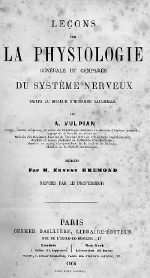
- Biography: http://www.whonamedit.com
- Born and educated in France, Vulpian early in his professional career reported on the vague origins of Crania; nerves III to X. Together with Charcot, Vulpian became co-director of the Salpêtrière. He discovered the chromaffin system of the adrenal marrow by the use of chromium salts. He studied and reported the use of drugs such as curae, strychnime, pilocarpine, nicotine and even ensthetics. He encouraged colleagues to enter the field of pathological anatomy. Known as a neuropathologist, he was also recognized as a clinical physiologist.
-
- " One can take the ape out of the jungle, but not the jungle out of ape "
- " When people commit genocide, we call them "animals". But when they give to the poor, we praise them from being "humane ".
- Frans De Waal
- Our Inner Ape
- Riverhead Books Ed
- New York 2005
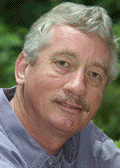
-
Autres documents mis en ligne ce mois-ci :
- Yawning Unzer JA 1771
- Parapraxes Szalai A 1934
- Le tic douloureux de la pommette G Soulagne 1804
- Yawning: unsuspected avenue for a better understanding of arousal and interoception Walusinski O
- Apomorphine-induced yawning in rats is abolished by bilateral 6-hydroxydopamine lesions of the substantia nigra Stoessl AJ, Dourish CT, Iversen SD
- Superior laryngeal neuralgia: carotidynia or just another pain in the neck? O'Neill B
- Lithium-triggered chronic cluster headache Brainin M
Résultats du sondageau 31 janvier 2006 Recherche par mot du site
-
Nombre de questionnaires remplis : 1921 - Combien de fois bâillez-vous par jour ? <5 = 24,7%.. 5-10 = 26,0%.. 10-15 = 15.4%.. 15-20 = 9,2%.. >20 = 24,7%
- Ressentez-vous des baillements excessifs ?
- 66,4% = non, tant mieux
- 28,3% = oui et je ne sais pas pouquoi
- 8% = oui et je prends des antidépresseurs
- 1,0% = oui et je prends des anti-épileptiques
- 4,6% = oui et je prends d'autres médicaments
- 2,7% = oui et j 'ai des troubles neurologiques
- 2,2% = oui et j 'ai des troubles hormonaux
- 2,7% = oui et j 'ai des tics moteurs
- 1,9% = oui et j 'ai des tocs
- déclenchez-vous facilement le bâillement d'autrui ? 74,5%
- êtes-vous sensible au bâillement d'autrui ? 73%
- La vie du site http://baillement.com en 2005

baillement.com baillement.info yawning.info écrits et réalisés par le Dr Walusinski
Voici le nombre d'abonnés à cette lettre : courriel à adresser lire les lettres précédentes d'information du site
